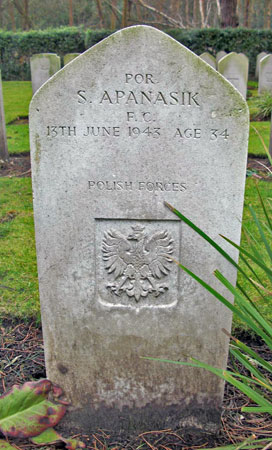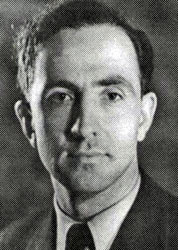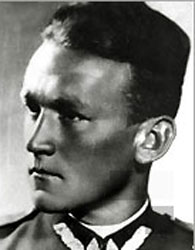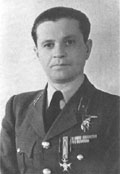Wellington R1697 damaged by enemy aircraft, landed at Lindholme airfield.
On 25th April 1942 this 304 Squadron aircraft was attacked at 16,500 feet by an Me110 while the crew were undertaking an operational flight to Rostock. The attack injured both the captain and rear gunner with the latter being seriously injured in his right arm. The bombload was jettisoned over Flensberg at 01.10hrs and the crew made for home. The aircraft had gone out of control for a time after the attack and although the pilot was able to re-gain control it had sustained damage to the rear gunner's intercom, and the hydraulics were put out of action and an oil tank was holed. The pilots brought the aircraft home to Lindholme airfield where upon one of the undercarriage legs collapsed. Upon landing it was found that the rear gunner was very seriously injured and he was admitted to Doncaster Hospital. The photograph shown above shows the damaged aircraft (photograph via "www.308.cieszyn.pl").
Both the pilot and his second pilot were commended for their actions in bringing the damaged aircraft home, both men received the Polish Order of Virtuti Militari, the citation
for their awards reads.. "The Commander-in-Chief wishes to bring to the notice of all ranks in the Command the courage and determination and skilful airmanship displayed by Acting
Squadron Leader Czetowicz and Flight Sergeant Ziolkowski, both of No.304 (Polish) Squadron. On the night of 24th April 1942, this officer and N.C.O. were Captain and Second Pilot
respectively of a Wellington 1C aircraft detailed to carry out an operational flight to Rostock. On the outward journey a surprise attack was made on the aircraft by an enemy
fighter which opened fire with machine gun and cannon, wounding the rear gunner in the arm. The Captain, while at the controls, also received wounds in the right arm as the result
of which he momentarily lost control of the aircraft, but by great effort, and despite the pain he was suffering, he managed to regain control at 12,000ft. Control of the aircraft,
which had been rendered very difficult by the extensive damage sustained, was then taken over by the second pilot, the bombs jettisoned by the Navigator, and course was set for
base. Despite the heavy damage which had rendered the hydraulic system and the undercarriage unserviceable, the second pilot made a successful belly-landing without further injury
to the crew. The safe return of the aircraft to base can only be attributed to the fortitude and great skill shown by both the Captain and Second Pilot."
Pilot - Acting S/Ldr Kazimierz Czetowicz PAF (P/0005). Injured in the attack.
Second Pilot - F/Sgt Konrad Ziolkowski PAF. (P/782064).
Navigator - F/Lt Bronislaw Franciszek Lewkowicz PAF (76657).
Wireless Operator / Air Gunner - F/Sgt Jozef Apanasewicz PAF (P780640).
Air Gunner - F/Sgt Konrad Jozef Paskiewicz PAF (P/783264).
Rear Gunner - P/O Stanislaw Apanasik PAF (P/1080). Injured in the attack.
Wellington R1697 was built to contract 992424/39 by Vickers Armstrong's Ltd. at Hawarden, Chester and was awaiting collection in March 1941. It was received by 18 MU on 28th March 1941. It was then taken on charge by 305 Squadron at Syerston on 23rd April 1941 but on 28th July 1941 it was transferred to 304 Squadron at Lindholme when 305 Squadron began conversion to Wellington MkII's. As a result of the damage sustained on 25th April 1942 Cat.A/FB damage was the initial assessment but this was risen to Cat.B/FB damage on 5th May 1942 and it was taken to the works factory at Castle Bromwich for repair. On 31st October 1942 it was flown to 48 MU and was then taken on charge by 30 OTU at Hixon on 28th November 1942. It then passed to 28 OTU at Wymeswold on 3rd February 1943 where it suffered two minor flying accidents where Cat.Ac/FA damage was the damage assessment. It was struck off charge on 31st March 1944 but not because of a flying accident.
A F/O Stanislaw Apanasik PAF (P/1080) died on 13th June 1943 and he is buried in Brookwood Cemetery, Surrey. He is listed elsewhere on the interent as having died as a result of the injuries sustained some fourteen months earlier but I cannot 100% prove this at the time of creating this webpage. His death is registered in Westminster, London. The "F.C." lettering on his grave would suggest that he was serving with Fighter Command which may rule out him still being with Bomber Command when he died. The photograph of his gravestone was found on "www.findagrave.com" and posted by "Charlie".
Kazimierz Czetowicz was born in March 1910 in Wilno, in what is now Lithuania. He joined the Polish Air Force in 1929 and having escaped Poland and after serving in France, he arrived in England and was posted to 304 Squadron rising to command the squadron. As well as the Polish V.M. he was awarded the UK DFC on 5th September 1942, the citation for which reads..“This officer has completed all his missions as captain of aircraft and his determination in the face of strong enemy opposition or in adverse weather has contributed to the successes attained. He has taken
part in five raids on Cologne and three on Bremen besides numerous other important enemy targets. He has set a splendid example to all.” He was posted away from 304 Squadron in January 1943 and would survive the War, he settled in England; possibly after changing his name to Cunningham. He died in London in January 1983.
Bronislaw Lewkowicz was born in March 1913 in Jaruslaw, Poland. He was initially in the Poland Army but transferred to the PAF in 1939. In September 1939 he was captured by Russian forces but escaped, via Romania to France and later England. When 304 Squadron moved to Tiree in May 1942 he was placed in charge of the advance party. 1943 saw a change in his work during the War; he volunteered to serve with the "Armia Krajowa", the main underground organization in Poland, and he was parachuted into Poland as an SOE operative to be known as "Kurs". He was involved in fighting against the SS Galizien Division in which he was badly wounded and later died and was initially buried in the cemetery at Leceniczowka. After the war he was exhumed and buried in the Catholic cemetery at Gielniowo, Poland.
Jozef Apanasewicz was born in July 1902. Little is known about his life in Poland but after completing a Tour of fifty operational flights with 304 Squadron he was awarded the British DFM. He survived the War and settled in the UK, he died in Croyden in July 1980.





On 15th July 1941 Sgt Paszkiewicz was in Wellington R1102 which crashed at Langham airfield in Suffolk, he escaped injury but the 304 Squadron aircraft was written off.
Mr Neville Bougourd's research into PAF aircrew has been viewed and used in compiling this webpage.